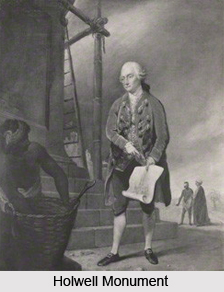 John Zephaniah Holwell was a surgeon of British East India Company, and a temporary Governor of Bengal from 1760. He was also one of the first Europeans to study Indian antiquities in early Bengal during the rule of Siraj in Murshidabad of Bengal. From his account the later British Government in Bengal erected the monument of British architecture called Holwell Monument or the Black Hole Monument in the modern Dalhousie Square Road in Kolkata. Due to the factual distortion of later British era, Bengal rose into nationalist sentiments and after a short protest by Netaji Subhas Chandra Bose, this Holwell Monument was transferred to the complex of St John"s Church, Kolkata.
John Zephaniah Holwell was a surgeon of British East India Company, and a temporary Governor of Bengal from 1760. He was also one of the first Europeans to study Indian antiquities in early Bengal during the rule of Siraj in Murshidabad of Bengal. From his account the later British Government in Bengal erected the monument of British architecture called Holwell Monument or the Black Hole Monument in the modern Dalhousie Square Road in Kolkata. Due to the factual distortion of later British era, Bengal rose into nationalist sentiments and after a short protest by Netaji Subhas Chandra Bose, this Holwell Monument was transferred to the complex of St John"s Church, Kolkata.
Early Life of John Zephaniah Holwell
John Zephaniah Holwell was born in Dublin. He grew up in London, and studied medicine at Guy`s Hospital.
Later Life of John Zephaniah Holwell
John Zephaniah Holwell gained employment as a surgeon in the English East India Company and was sent to India in 1732. He served in this capacity until 1749.
Survivor after Seige of Calcutta
John Zephaniah Holwell was a survivor of the Black Hole of Calcutta on June 1756, the incident in which British subjects and others were crammed into a small poorly ventilated chamber overnight, with many deaths. The account of this incident (1758) obtained wide circulation in England and some claim this gained support for the British East India Company`s conquest of India. His account of the incident was not publicly questioned during his lifetime or for more than a century after his death. However, in recent years, his version of the event has been called into question by many historians.
Contribution of Holwell in Bengal
John Zephaniah Holwell has also become an important source for modern historians of medicine, as a result of his description of the practice of smallpox vaccination in eighteenth-century Bengal
Appointment as a Zamindar of Calcutta
In 1751, John Zephaniah Holwell was appointed as zamindar of North and South 24 Parganas District of Bengal. He then served as a member of the Council of Fort William (Calcutta) and defended the settlement against Siraj ud Daulah in 1756.
Other Appointments of John Zephaniah Holwell
John Zephaniah Holwell later succeeded Robert Clive as temporary Governor of Bengal in 1760, but was dismissed from the Council in 1761 for remonstrating against the appointment of Henry Vansittart as Governor of Bengal. He was elected Fellow of the Royal Society in 1767.
Related Articles
Capital Cities of India
Kolkata
History of Kolkata
Medieval History of Kolkata
History of Victoria Memorial , Kolkata
Culture of Kolkata
Monuments in Kolkata, West Bengal Monuments
British East India Company
British Empire in India
Impact of British Rule in India
Early Voyages of British East India Company
British Indian Acts
Battle of Plassey
Significance of Battle of Plassey
Siraj-Ud-Daulah, Nawab of Bengal
Mir Jafar, Nawab of Bengal



















